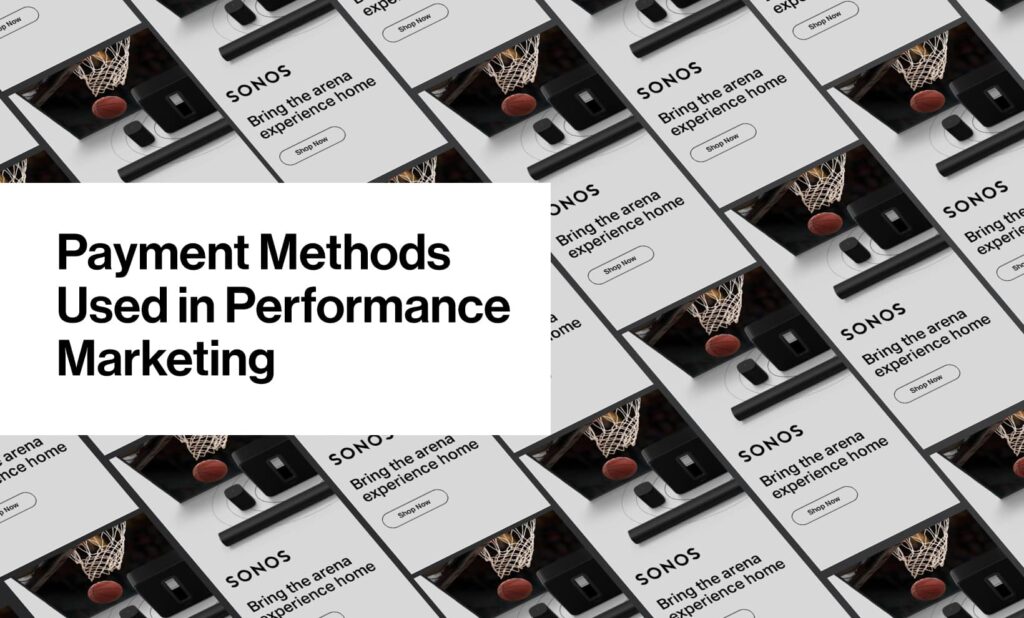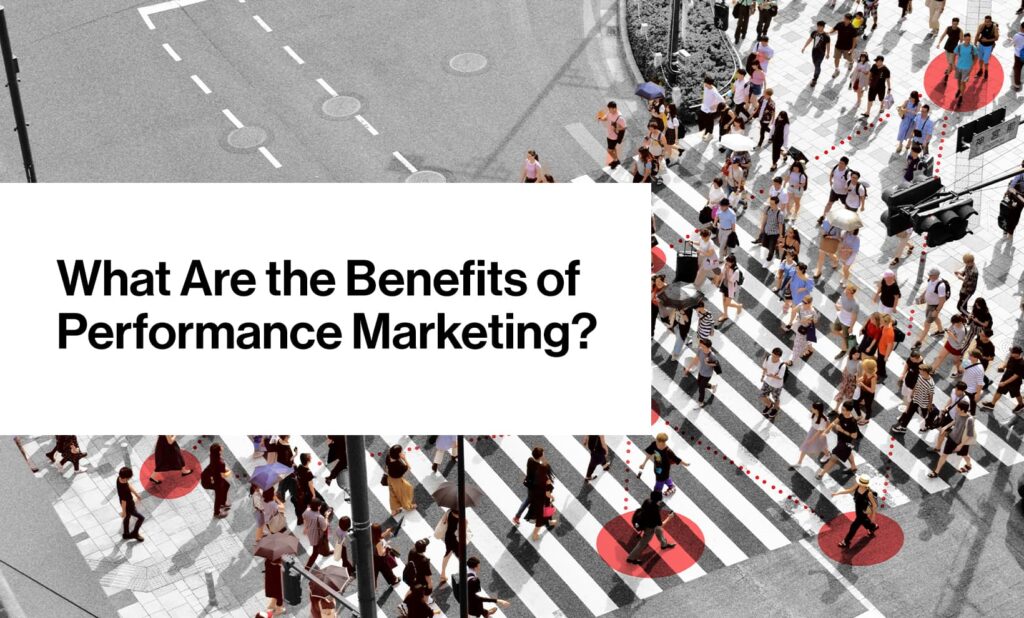If you are looking for a results-driven strategy for your digital advertising, performance marketing could be your answer. This approach has changed the way marketers and publishers interact and how ads reach target audiences. In a data-hungry world, performance marketing offers the ability to reach your target audience at scale, while still measuring how well your campaigns are working.
Table of Contents:
- What Is Performance Marketing?
- How Does Performance Marketing Work?
- Performance Marketing Channels
- What Are the Benefits of Performance Marketing?
What Is Performance Marketing?

As the name implies, this type of marketing is based on performance, with advertisers paying based on how well an ad performs or how many people see it. Traditionally, performance marketing included only PPC (pay per click) or CPC (cost per click) campaigns, but today it goes beyond engagement or click-through rates, to include impressions or views on a CPM (cost per thousand) basis.
As a marketer, you place ads and pay when the desired action is completed. It’s a highly desirable arrangement since you can be sure you are paying for quality views or other results. Depending on the payment model you use, you may gain some free brand exposure from viewers who do not click on the ad. In general, you can earn a high return on each click or view that is generated.
One critical way to drive results through performance marketing is via targeted omnichannel campaigns. By targeting your ads across multiple channels, such as display, video, social, search, audio, native, etc, you can find engaged audience members wherever they are online. When advertisers pay for impressions, the true measure of success is whether the right people have seen the ad.
How Does Performance Marketing Work?

There are three groups involved in digital performance marketing, who each have a vested interest in promoting a successful advertising campaign. They include:
1. Advertisers
Consumers visit websites and social media platforms regularly. They also stream content on connected TVs and audio platforms. In order for a marketer to reach and engage with their target audience online through a digital advertising campaign, they generally use a cross-channel marketing campaign. If the goal of the campaign is to generate leads and increase sales and conversions (as opposed to brand awareness) by engaging consumers to take a particular action, performance marketing is the way to go.
2. Publishers
Publishers include any company that owns and operates a website that sells digital advertising on it. Depending on the website content, each publisher provides access to a specific group of readers or subscribers, which may include niche or broad viewership with distinct segments. Advertisers bid on ad space with these publishers for the audience members they wish to target, which can be done in either a private marketplace deal between the marketer and publisher or programmatically. When the members of the advertiser’s target audience are on the publisher’s site, the ads appear in front of them.
Advertising across a variety of marketing channels allows you to reach a larger potential customer pool, and keep your audience engaged across screens so that your brand remains top of mind. You could start with traditional banner ads (display), and then move into social media, paid search, and CTV ads in order to connect with your audience across multiple channels.
3. Agencies & Trading Desks
For advertisers who don’t have direct relationships with publishers and platforms, they choose to work with agencies and trading desks to handle the media buying and selling on their behalf. The type of relationship between the advertiser and their media partner can vary, but in performance marketing, it is the agency’s responsibility to ensure that the ad performs and is seen by the marketer’s target audience.
A programmatic trading desk, like AUDIENCEX, offers access to multiple demand side platforms (DSPs) for programmatic, search and social advertising so you can access them all in one place. It also offers strategic recommendations for programmatic media buying and a unified reporting interface, so that the advertisers understand which of their channels or creatives are working best and reaching the right people.
Payment Methods Used in Performance Marketing

In performance and programmatic media buying, payments are usually determined at the start of an ad campaign. Payment models can be set by the publisher or platform, and advertisers can decide how much they are willing to bid for their desired result. The two main payment types include:
- Pay per click (PPC): The advertiser pays for clicks that take visitors to the advertiser’s landing page. This method is used in paid search engine results.
- Cost per click (CPC): Another way to describe PPC above. Also a KPI (key performance indicator) that marketers use to understand how efficiently their media buys are performing. If one campaign on paid search has a CPC of $400, whereas a display campaign has a CPC of $20, the advertiser may choose to shift their marketing budget to the display channel for efficiency.
- Cost per thousand (CPM): The easiest to use and most common payment model, CPM is a calculation of the price a marketer pays per 1,000 impressions. Rather than paying for someone clicking on an ad, the advertiser is paying every time the ad is shown to someone in their target audience. This method can be useful when the campaign goal is to increase product or brand awareness. It can also engage those who have expressed a high level of interest in your brand. CPM can be used for paid social media, programmatic advertising and many other platforms. When paying for views, it’s crucial to use sophisticated targeting to ensure impressions and results from engaged audience members.
Performance Marketing Channels

There are many performance marketing channels available to an advertiser, and most performance marketing tactics can happen programmatically. In these cases, the content is delivered to platforms and individual users strategically so that marketers are paying for valuable impressions or clicks.
A few other proven strategies for performance in digital marketing are high-impact visuals and formats. In a world where most online users try to avoid ads, making designs stand out can increase views, clicks and conversions. Formats for advertising should also be varied and engaging. Videos, mobile-first designs, digital audio ads, personalized Dynamic Creative Optimization (DCO) and other ad formats ensure your brand can develop a rich, omnichannel online experience. Engaging formats ensure that after ads find the right viewers, those audience members will be excited to learn more.
Social Media Advertising
In the U.S., 72% of the population uses at least one social media platform. Most marketers can find engaged audience members on social media. Each platform has a unique niche.
While Facebook and Instagram have the most diverse user base, others may offer targeting for specific purposes. Pinterest has users in search of unique products, making it perfect for e-commerce. B2B marketers may focus on LinkedIn, where professionals foster personal career growth and seek business tips. TikTok and Snapchat attract more millennials and Generation Z users.
Social media is often used to gain traffic, boost engagement, generate leads or sales, and increase brand awareness. With organic reach only going so far, paid content is crucial to improve post performance. Some performance metrics advertisers can track in social media performance marketing include:
- Impressions
- Likes
- Comments
- Shares
- Clicks
- Sales
- Completed contact forms
- Checkouts
While there are many metrics you can track in social media, the most often-used payment model is the CPM. Social media platforms offer several ways to ensure those impressions come from audience members most likely to be interested in your products or services.
Programmatic Display Advertising
One of the most effective ways to drive results through a marketing campaign is through programmatic media buying. While almost all forms of performance marketing today can take place programmatically, display ads are one of the most well-known. By going through specific publishers to place banner ads, you can take advantage of advanced contextual targeting. Publishers gather a wealth of audience and segmentation data on their readers to help place highly-targeted ads.
For example, if you sell cars, an online magazine about car collecting is a natural fit for display advertising. Depending on the publisher, you might be able to access a particular segment of readers interested in the kinds of cars you sell.
The advantage of programmatic display advertising is that you can access those same audience members and others throughout the web. Those car magazine readers may also be reading the news, where you can target them again with more banner ads. You may have readers interested in minivans frequenting a parenting blog or readers interested in high-end sports cars visiting a wealth management site. You can target them all with programmatic display advertising.
Native Advertising
Native advertising is a form of advertising that doesn’t look like an ad. Instead, it mimics the content and function of the site or page it’s placed on. Native ads often come in the form of suggested articles at the bottom of a news or social site and can also appear in-feed on social media platforms. Native advertising can also be bought or sold programmatically, to show native ads to users based on their interests and viewing history.
Good native advertising educates and informs customers at the top of the sales funnel, rather than using explicit sales language. By capturing customers’ interest, it creates prime opportunities for retargeting to help move the user along the consumer journey.
Because it imitates the other content on the site, native ads often get more clicks than traditional advertising. It usually takes the form of CPM advertising.
Search Engine Marketing (SEM)
Search engine marketing, also known as PPC or Paid Search advertising, combines native advertising through sponsored search results with other forms of marketing. Advertisements on the top of the search results list are often called PPC ads. Besides performance-based ads, marketers also use search engine optimization (SEO). This tactic relies on the search engine’s algorithm to gain organic clicks. While SEO doesn’t have to follow a performance marketing model, some marketers use the results of SEO campaigns to pay commissions to SEM companies. You can measure both organic and paid search marketing performance using hard metrics to understand success.
High Impact Mobile Advertising
Mobile devices are one of the most popular to target for performance marketing. It’s right in the name — they travel with their owners. As a result, they let you reach your customers 24/7 wherever they go. As a side effect, most audiences are inundated with mobile ads all day long. It’s enough to make most consumers put up an invisible wall, ignoring every pop-up their phones throw at them. Enter high impact mobile ads.
They’re a new breed of attention-grabbing mobile ads. They drive engagement because they take advantage of all the tools our pocket-sized touchscreens have to offer. All the most-used apps delight users and draw them in. High impact mobile ads draw on this formula with swipes, taps and other interactive elements. They use eye-catching designs and thoughtful movement to break through the visual noise of the digital landscape. Mobile experience designers build interactive concepts based on what’s relevant to your target audience. Meanwhile, sophisticated programmatic advertising techniques land them in front of the right eyeballs.
AUDIENCEX’s high impact mobile gallery showcases some of the opportunities for a customized, exciting experience these ads can offer. Full-screen ads draw attention to the content and prompt users to swipe or tap learn more or watch a video. They can also provide a “choose your own adventure” setup, where audiences select the features or products they want to learn more about. The opportunity for creativity abounds, and the format boasts impressive performance. Their high engagement and click-through rates combined with precision targeting make them worth the investment.
Video and CTV
Engaging, high production value video ads offer impressive engagement. The video format is a rich tool to raise brand awareness and capture audience members in the upper-funnel. Like the other forms of performance marketing, video ads work best when placed programmatically. You can embed them within a video or roll them before or after other video content. They can also appear within display ads or mobile games.
Video ads on a connected TV perform even better. They offer advanced targeting and drive performance in a way traditional network television commercials can’t complete with. A connected smart TV lets you target specific users from the comfort of their own homes. When shown on premium streaming content, CTV video ads have at least a 90% completion rate.
What Are the Benefits of Performance Marketing?

What makes performance marketing different? It’s right in the name — performance. When it comes to effective marketing focused on the return on investment (ROI), it is the strategy advertisers turn to. It incentivizes measurable results and makes metrics easy to track.
Here are the top five benefits of performance marketing:
1. Track Performance
The beauty of performance marketing is it’s 100% measurable. Trading desks like tdX from AUDIENCEX track views and clicks, for a holistic understanding of how your ads perform on different platforms. Since you pay per impression or click, it also becomes much easier to track ad spend and optimize your media buy. From there, you can calculate a cost-per-action, allowing you to see how many views it takes to generate one click, one lead or other performance metrics you wish to track.
With marketing turning increasingly digital, it has demystified the path to conversion. While it can be hard to attribute success to traditional, linear TV commercials, performance marketing is different. Performance marketing not only allows a marketer to increase reach but offers trackable metrics, so the marketer can instantly know which ones are driving conversions. For marketers who are always asked to justify their media spend, being able to calculate ROI reliably is crucial.
2. Pay for Results
The last thing marketers want is an ad that falls on deaf ears. Or worse, targeting users who will never convert. With programmatic advertising, publishers have incentives to get your ads seen by the right audiences at the risk of losing your future ad placements. So, ads can earn more targeted impressions alongside improved conversion rates.
Because advertisers pay for results, there is a low-risk for wasted ad spend. Even if the cost-per-impression rises, marketers can trust that they are paying for viewer interactions. A study from the Performance Marketing Association estimates that marketers can receive a 12:1 return on performance marketing.
3. Connect With New and Hard-to-Reach Audiences
Performance marketing offers many formats, including social media, native ads, CTV ads, audio ads, display ads and search marketing. These open your brand to the audiences on each platform, unlocking new markets. Content filtered through trusted publishers and the platforms your customers use most can reach viewers who block or ignore most ads online.
Working with a trading desk allows ads to find placements across the web on multiple outlets. So, you can expand your reach significantly.
4. Optimize Campaigns as They Progress
The digital nature of performance marketing means you can track performance in real-time. So, you can adapt ads throughout the life of a campaign. With advertisements in various locations across many channels, you can see where ads perform well and increase focus on those platforms. If you notice one tagline performs better, you can change others to match mid-campaign.
Your ad placement will be optimized on the publisher’s side, depending on the metrics you’ve chosen. For example, a search engine will show an ad often enough to garner the objective number clicks within the campaign’s timeframe, so long as the bid meets the requirements.
5. Budget Effectively
Marketers have to set goals at the start of a performance-driven campaign. So, these advertisements become easy to plan for. While bidding on each platform can work differently, most will ask for an ideal cost per impression and a goal for total impressions. While the price can deviate from the ideal over the life of a campaign, this method makes it easy to estimate and track spending. Many platforms also allow you to set a spending limit.
Contact AUDIENCEX
Are you looking for an omnichannel performance solution built for performance the way you are? You’ll see a 5%-20% increase in performance across search, social media, and Amazon when you work with us. At AUDIENCEX, we want to help you connect with your audience across all channels and have complete clarity over your ad performance. We combine smarter targeting with the best programmatic advertising and performance marketing solutions. When it comes to the numbers, we offer a clear understanding of how your campaigns are performing. We’ll manage your campaigns for the best possible outcomes throughout their lifecycles.
Sound right for you? Let’s chat.
Get the Guide: 5 Steps to Prepare for the Loss of Third-Party Cookies
In preparation for what’s to come, we’ve created a guide with 5 ways to plan your programmatic advertising strategy without the use of third-party cookies.
Fill out the form below to download the guide.

